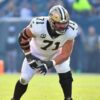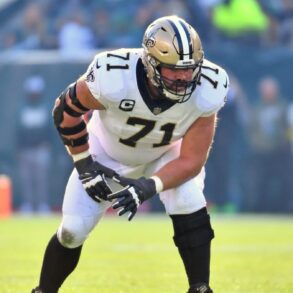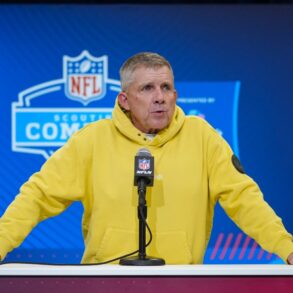You’ve heard it a million times by now: The 2025 QB draft class is relatively weak. There is one quarterback who looks like he could develop into an elite one (Cam Ward). There are a few potential solid starters, but will teams reach for one in the first round? There are some developmental prospects, like Jaxson Dart and Jalen Milroe, but they could use a season on the bench. This is my final ranking of the top 10 (my full scouting reports for some of the prospects are linked within these write-ups).
Advertisement
1. Cam Ward, Miami
Coming from a Wing-T offense in high school, Ward improved every season in college. He has an innate awareness that is hard to teach, finding open receivers who seem to be out of his line of sight or who shouldn’t be open against certain coverages. He’s not an elite athlete but consistently finds ways to elude pass rushers to buy time or scramble for first downs. He has good arm talent with the ability to make every throw from on- and off-platform.
Ward tried to make the big play too often, which led to too many negative plays. He has to be more willing to take check-downs and easy completions in the NFL. He tends to be too reactive to pressure, drifting or breaking the pocket too early at times. He’s not a tier-one athlete and doesn’t have an elite arm but his superpower is awareness of everything happening on the field. If he can rein in the hero ball, he has the potential to be one of the star playmakers and needle-movers at the position.
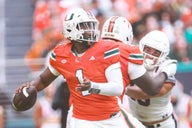
GO DEEPER
Breaking down Cam Ward’s superpower and why it sets him apart in the NFL Draft
2. Shedeur Sanders, Colorado
Sanders is a fine prospect; he does a lot of things well but not at an elite level. He’ll sniff out blitzes and change protections at the line of scrimmage and is intelligent enough to help make halftime adjustments with offensive coordinator Pat Shurmur. He has an average to below-average arm. His deep balls have a tendency to be underthrown, forcing his receiver to come back and make a great catch. He processes well and is willing to make throws in the middle of the field. He has good accuracy but it’s not elite like Joe Burrow’s was in college. He’s also an adequate athlete but attempts to make plays out of structure like he’s a much better athlete. He improved his pocket presence last season but has to stop drifting in the NFL or attempting to make as many out-of-structure plays — the pass rushers in the NFL will be more athletic. Sanders will be able to come in and play right away and has a relatively high floor, but he has a limited ceiling.
3. Jaxson Dart, Ole Miss
Dart has an intriguing set of tools. He’s not tall (6-2), but he’s well-built (225 pounds) and he’s an excellent runner who can be used in the QB run game and do damage as a scrambler. He has the second-best arm talent (to Cam Ward) in this draft class, which doesn’t feature a lot of spectacular throwers. He can throw accurately off the platform and maintain accuracy while getting hit.
Advertisement
The biggest concern with Dart is that he’s coming from a simplistic offense that doesn’t translate in the NFL. Head coach Lane Kiffin was excellent at calling plays that got Dart’s first read open, but Dart struggled when getting late in his progression. A good example of that is against Florida. Early in the game he hit his first reads for big plays, but late in the game, when Florida took away those reads on the same concepts, he still threw the ball into coverage. In my opinion, Dart will need to sit and learn an NFL offense before playing.
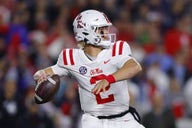
GO DEEPER
When should Jaxson Dart be drafted? Evaluating pros and cons of the Ole Miss QB
4. Will Howard, Ohio State
Howard has top percentile size (6-4, 234 pounds) and is a running threat. Chip Kelly used him not only on option plays but straight quarterback run plays in short yardage. Howard has good pocket awareness, can rip away from tackles, and tends to step up into the pocket when feeling pressure. He has very good arm talent and can make every single throw and attack all areas of the field. Though he will have the occasional miss, he has a great understanding of ball placement. If he can clean up his technique and gain a little more control, ball placement will be a highly valuable trait for him. He has experience in an under-center offense that utilized a variety of concepts. His experience in Kelly’s offense has him well-prepared to step in and be able to operate most NFL offenses. After his worst game of the season against Michigan, he had a four-game stretch that was as strong as any quarterback’s in this draft.
Kelly’s play designs and a great receiving corps created a lot of wide-open opportunities. Ohio State was one of the best play-action offenses in college football, which created simple but explosive opportunities. Howard wasn’t in a position to have to operate a lot of true drop-back concepts. He had a tendency to lock onto his first read, especially on play-action concepts on which he was very aggressive, leading to some turnover-worthy plays. On his misses, he would over-rotate into his throws. The best throwers in the world rotate their hips into throws first, but they’ll also stop rotation at a point. When Howard misses you’ll see his hips and shoulder go past the point it should, causing him to lose control of passes.
Overall, I like Howard’s combination of physical traits, football I.Q., and ability to execute all the different concepts in Kelly’s offense in his first year in that system, especially considering he came from a heavy-QB run system at Kansas State. Howard’s shortcomings are more easily fixable than some of the other developmental quarterbacks in this year’s draft. Though many have compared Alabama’s Jalen Milroe to Jalen Hurts, Howard fits that mold (power runner who throws accurately outside and took a big leap in his senior season) more than Milroe.
It is about SUDDEN START and SUDDEN STOP of CORE TURN! @NFAcoach #quarterback understand #F4 by @SportcorePro Watch the FRONT HIP SNAP. Ryan’s glutes are loaded and his inner unit core is engaged and stabilized so his hips can rotate! Note his back leg DOES NOT drive through. pic.twitter.com/PraMwgwWLb
— JC Boice (@jcboice) December 8, 2017
5. Tyler Shough, Louisville
Shough could be one of the biggest pre-draft risers in this class. His film is excellent and he displayed many high-level traits. He’s a rotational thrower with a quick release and doesn’t need a lot of space in front of him to throw with accuracy and velocity. He’s a good athlete who can get away from the pass rush and make plays outside of structure.
Advertisement
Because of multiple injuries throughout his college career, he’ll be 26 years old as a rookie. Additionally, his play drops significantly when pressured (four out of his six interceptions last season were thrown when he was under pressure). Shough can start right away for the team that drafts him, appealing to teams that don’t have the time to deal with the growing pains of this class’s greener quarterbacks.
6. Jalen Milroe, Alabama
Milroe will be one of the best athletes at his position as soon as he lines up under center for the first time. The team that drafts him will be able to run an option offense featuring a 220-pound quarterback who runs in 4.3-4.4 range. The ball explodes out of Milroe’s hand. He throws with a ton of velocity and distance. There were examples of him getting through multiple progressions on dropback concepts on film but overall, he lacks a feel for the passing game in terms of timing, ball placement, and where the pass rush is. He does things you can’t teach, but what he has to improve can be difficult to fix in a league that lacks patience.
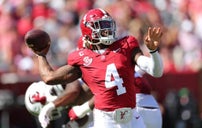
GO DEEPER
Jalen Milroe film review: Why a potential NFL Draft gem needs extensive polishing
7. Kyle McCord, Syracuse
McCord is decisive — the time between making up his mind and getting rid of the ball is very quick. Strong footwork helps him quickly and properly align his body on throws. He’s excellent at reading defenses and sniffing out blitzes pre-snap. He has a strong technical framework to work with. Among the 22 quarterbacks PFF ranked, McCord had the quickest time to throw (2.4 seconds) and was fifth in big-time throw rate, but he ranked 17th in turnover-worth play rate.
He is adept at streamlining his progressions based on pre-snap reads but will stay locked on his first read for too long and will force the ball there. He has the accuracy and ball placement to force-feed his first read but that also led to turnover-worthy plays. He has an average to below-average arm. His passes on outbreaking balls and deep throws die. He has a bad habit of spinning backward to get outside of the pocket.
Shanahan-tree coaches will love his ability to quickly get rid of the ball because they’ll trust their ability to get his first read open. He fits that mold to a tee, but he’s willing to take more chances downfield. I wouldn’t be surprised if a team that runs that system jumps on him in the third round, but McCord’s turnover-worthy play rate is the red flag that might keep him from going that early.
8. Riley Leonard, Notre Dame
Leonard is an excellent scrambler who has long strides with surprising wiggle for a tall, lanky quarterback. He can be used in the QB run game and he can create big plays on scrambles. He has a knack for making plays when his team needs it most. Though his arm is just better than average, he can make every throw with velocity and throws an effortless deep ball. He’s willing to stay in the pocket and make throws while getting hit and consistently steps up in the pocket through pressure.
His mechanics have to be revamped. He can over-stride into throws and his front shoulder flies open before his hips, causing inaccuracy (a lot of misses on film). He doesn’t throw with anticipation and hesitates to throw even when seemingly looking at open receivers. He didn’t identify blitzes consistently and didn’t streamline his progressions based on pre-snap reads.
Leonard has intriguing physical tools with leadership, toughness, and athleticism, but he has a lot of work to do with his mechanics and footwork to be a competent starter. For now, he can at least be a backup who can give the defense a different look as a runner and maybe make enough plays to steal a win if a starter goes down. The intangibles combined with tools could make him a worthwhile investment in the later rounds.
Advertisement
9. Kurtis Rourke, Indiana
Rourke has prototypical size (6-4, 220 pounds). He doesn’t have as strong of an arm as you would expect from a quarterback with his size, but he can make every throw with relative ease. He throws accurately into all areas of the field and throws with good ball placement. He throws with touch and anticipation. He’s willing to stand in the pocket and deliver throws under duress.
Rourke fits the profile of a classic pocket quarterback but he has slow feet and is a statue in the pocket. It was commendable that he played on a torn ACL all season and underwent surgery on the thumb of his throwing hand. He was more willing to run before he was hurt but his speed was still average at best. His game won’t require him to run as much. He doesn’t hold the ball very long — he ranked third in average time to throw (2.55 seconds).
He was in an RPO-heavy offense at Indiana but they also threw the ball downfield a fair amount. He’ll have to learn how to play from under center in the NFL. Also, health is an issue as he’s had to deal with a plethora of injuries throughout his career. Rourke has the tools to be a good backup in the NFL.
10. Quinn Ewers, Texas
Ewers is a nimble athlete who can pick up first downs when the defense is out of their pass-rush lanes. Though he’s willing to scramble, he isn’t a big-play threat (6.6 yards per scramble). He has a quick, snappy release, which helps him execute Texas’ extensive RPO menu. Ewers can generate a lot of power without a lot of space on his throws and is willing to take chances downfield.
He isn’t willing to throw the ball into tight windows in the intermediate range and lives off deep throws or quick passes. He is not a precision deep-ball passer. He completed a lot of deep passes because he had NFL-caliber receivers, but he’s throwing into general areas rather than throwing with precision. He’s sensitive to pressure and is too willing to drift back or throw the ball off his back foot. Despite his above-average athleticism, he gets taken down by pass rushers too often and easily. His 23.2% pressure-to-sack rate was well above average (18.7%), meaning pressures turned into sacks too often.
Ewers has a strong arm and a quick release but his accuracy, especially his deep ball, was very spotty. Also, he played in a simplistic RPO offense in which head coach Steve Sarkisian did an excellent job of designing and calling plays that got Ewers’ first read open often. There weren’t many examples on film of him getting deep into his progressions. He put the ball in harm’s way too often. According to PFF, he had a turnover-worthy play rate of 4% (average is 3.5%). Overall, Ewers has a nice arm and plenty of experience, but his negatives far outweigh his physical tools. His lack of success in the true dropback game and turnover-worthy play rate make me question whether he would even be a reliable backup. To his credit, he’s a tough kid who played through injuries, but he’s also been injury-prone.
(Illustration: Demetrius Robinson / The Athletic; Top Photos: Adam Cairns/Columbus Dispatch/USA Today Network, Carmen Mandato, Wesley Hitt / Getty Images)
This post was originally published on this site be sure to check out more of their content.


